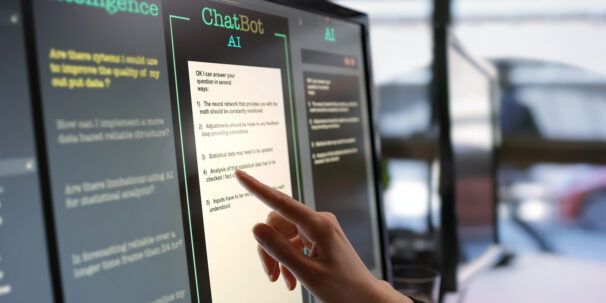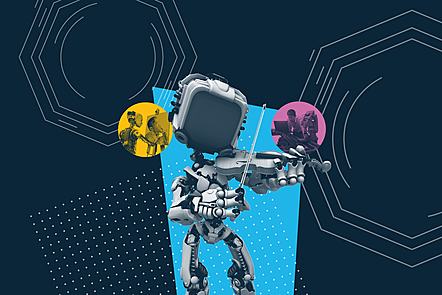What is generative AI? Your biggest questions answered
Discover everything you’ve ever wanted to know about generative AI, including what it is, how it works, and whether you should be worried about sentient AI.

Generative AI is hard to escape right now – and for good reason. The global generative AI market has nearly doubled in the space of two years, from $7.6 billion in 2021 to $13.71 billion in 2023.
But what exactly is GenAI and how is it impacting society? Should you be using it, since everyone else seems to be? And what are the biggest ethical implications of increasingly advanced, AI-generated content? We’ll answer these questions and more, pointing you in the direction of our best generative AI courses.
What is generative AI?
Maybe you’ve heard of ChatGPT, but you’re still not 100% sure what generative AI actually means. We’re here to explain.
Generative artificial intelligence (GenAI) comes under the umbrella of machine learning and describes a type of AI algorithm that can instantly generate new content based on prompts given by humans. This content creation is pretty expansive – generative AI can create images, models, text, audio, video and more.
If you’re unsure what machine learning is – it basically does what it says on the tin. It’s a form of artificial intelligence where machines are able to learn from data to make more informed decisions or predictions. Generative AI takes this one step further by actually creating content based on those predictions.




How does generative AI work?
Large quantities of data are fed into generative AI models, which then decipher repetitive data patterns using an advanced neural network that is based on the human brain. Once the AI has detected these patterns, it’s able to predict similar patterns and deliver creative output based on these predictions when prompted.
Now that generative AI has become quite advanced, it’s possible for these human prompts to be written in simple, human language, and for the AI to accept feedback on the output and customise it further. For example, if generative AI creates an image for you based on a prompt, you can ask the AI to make further edits to the image size, lighting, and other details.
Check out this example of ChatGPT responding to a prompt we wrote:
A brief history of generative AI
You may have just discovered generative AI, but research into the field began as early as 1950. Alan Turing created the famous Turing test – it suggested a machine was intelligent if it could generate question responses that couldn’t be distinguished from human responses. Seems familiar? That’s because the ability to give human-like responses is one of the most fundamental attributes of generative AI.
In the 60s, Joseph Weizenbaum developed ELIZA, known as the first chatbot. It could respond to phrases with an open-ended question, creating the illusion of chatting with someone. The next chatbot wasn’t created until 1995, but ALICE was able to use natural language processing (NLP) in order to simulate a more natural and sophisticated conversation.
Neural network technology developed over the following decades, but it wasn’t until 2014 that a new kind of algorithm was created – a generative adversarial network (GAN). This allowed generative AI to create new kinds of authentic output like images, audio and video.
In 2018, OpenAI published a research paper about Generative Pre-trained Transformers (GPTs) – neural networks that were designed to mimic human brain function and could carry out a vast array of tasks. Since then, GPT has evolved several times and developed into the sophisticated chatbot we know today.
What are the most popular generative AI interfaces?
Let’s dive into some of the most popular generative AI interfaces that are making waves. This isn’t a definitive list, and the number of interfaces will certainly grow in the near future, but it’s a good starting point.
ChatGPT
Who better to explain what ChatGPT is than itself? Here’s the response the chatbot generated:
“ChatGPT is a language model developed by OpenAI. It is based on the GPT (Generative Pre-trained Transformer) architecture, specifically GPT-3.5, which is one of the most advanced versions of the GPT series as of my last update in September 2021.
GPT-3.5 is a deep learning model designed to understand and generate human-like text. It is pre-trained on an extensive corpus of diverse internet text, making it capable of grasping the nuances of language and generating coherent responses to a wide range of prompts.”
Bard
In the words of Bard itself:
“Bard is a large language model, also known as a conversational AI or chatbot trained to be informative and comprehensive. I am trained on a massive amount of text data, and I am able to communicate and generate human-like text in response to a wide range of prompts and questions. For example, I can provide summaries of factual topics or create stories.
The name “Bard” was chosen because it is a reference to the traditional role of bards as storytellers and keepers of oral tradition. I hope to continue this tradition by helping people learn and explore new ideas through the power of language.”
Dall-E 2
Since Dall-E 2 isn’t a chatbot, we couldn’t get it to generate a description. Rather than being language-based, Dall-E is a generative AI technology that allows users to create authentic images and art based on a text or image prompt. It has the ability to combine different concepts and art styles.
Originally created in 2021 by OpenAI, Dall-E was upgraded to Dall-E 2 last year and now creates images with a resolution four times greater than before – the quality of AI imagery just keeps getting better.




What are some generative AI applications?
Getting into specifics, what are the applications of generative AI? Broadly, they can be split into audio, visual and language applications. Take a look at some examples below, though these don’t cover all possible applications of GenAI.
Audio applications
- Music and audio composition
- Speech-to-text tools
- Voice generation
Visual applications
- Generative AI art
- 3D models
- Video generation
Language applications
- Chatbots
- Foreign translation
- Code development
- Creative writing
Which industries use generative AI?
With the capabilities of generative AI expanding fast, almost any industry could make use of features like 3D modelling, text generation and code development. But which industries are we seeing currently use generative AI?
- Healthcare – uses of generative AI in the healthcare industry include drug discovery, medical transcribing, genomic analysis and medical imaging.
- Finance – some examples of applications in the finance industry are deep analytics, customer chatbots, fraud detection and recommender systems.
- Marketing – generative AI can be used for copywriting, content creation, chatbots and email marketing.
- Manufacturing – applications of generative AI in manufacturing include 3D modelling, new and innovative product designs and optimised supply chain.
Advantages and disadvantages of generative AI
Advanced technology like generative AI has so many applications and consequences for society, so it’s important that we have a solid understanding of both the good and bad implications. Below, we discuss some of the biggest advantages and disadvantages of generative AI, though this is not an exhaustive list.
Advantages of GenAI
- Speed and efficiency – there’s no doubt that GenAI makes many tasks much faster and more efficient, from design and data analysis to writing and content creation, saving people and businesses a lot of time and money.
- Analysis of vast amounts of data – generative models can understand and organise large quantities of data at a rate much faster than humans can, immediately finding patterns, correlations and risks.
- Low cost – if you’ve heard the phrase “time is money”, you’ll understand that generative AI can save businesses a lot of money by getting things done instantly, and in many cases (take ChatPT as an example), for free.
- Access to information – search engines like Google have given us incredible access to information, but generative AI takes this one step further by being able to answer our specific queries and follow-up questions in an instant.
Disadvantages of GenAI
- Bias – since generative AI “learns” from society, if bias exists in society, it will also exist in generative AI. For example, Bloomberg found that image-generating AI demonstrates extreme race and gender stereotypes. Developer bias also comes into play here – this is clearly a massive concern if we are to increase our reliance on GenAI.
- No copyright – the whole basis of generative AI is that it learns from the work of others, but what does this mean for copyright issues? Many artists, writers, musicians and other creatives have expressed concerns that AI is stealing their unique style and creative talent, which could leave them vulnerable to unemployment. The question we’re all wondering is – what counts as intellectual property theft? Not to mention, since your likeness isn’t protected by copyright, highly realistic deepfakes can be created by AI – this introduces a vast array of ethical complications.
- Lack of originality – if GenAI can only ever be influenced by the work of other people, can anything it creates ever be truly original? Many argue that it can’t be, and this is why some creatives aren’t worried about their jobs and livelihoods.
- Inaccuracies – the information offered by GenAI interfaces do not have to be 100% accurate. In fact, it’ll often give false or made-up information, which could be a big concern if people take what it says as total fact.
- Ethical considerations – there are a whole load of other ethical considerations besides the disadvantages above, and the reality is that many people don’t truly understand the implications of GenAI. This ignorance could be dangerous.
Popular concerns about generative AI
We can’t talk about the ethical considerations of generative AI without addressing the most popular concerns people have. Is this the end of our world as we know it? Let’s discuss.
Is generative AI stealing our jobs?
There’s no doubt that businesses are starting to invest in generative AI. PWC is planning to invest $1 billion in generative AI technology over the next three years, and AWS is investing $100 million into a generative AI centre. Do these investments come at the expense of new jobs for humans?
It’s already clear that generative AI may take over a lot of the time-consuming, admin-intensive grunt work that exists. While this might be a good thing for creatives and business executives who want more time for other things, this could lead to the end of some jobs – admin assistants, transcribers, accountants and customer service representatives, to name a few.
And creatives are certainly not in the clear. With instantly generated art, photography, video, music and creative writing at everyone’s fingertips, will businesses and individuals still pay creatives for original work?
As we previously explained, the creativity and originality of GenAI has limitations, but some people will undoubtedly choose less effort, time and money over human creativity. Take what happened with the AI Lensa app as a case study.
The World Economic Forum has estimated that artificial intelligence will replace 85 million jobs by 2025, so this concern is definitely not unfounded. There will, however, also be many new jobs created.


Is there a danger of sentient AI?
Here it is, the age-old question – will robots take over the world? It feels like a more pressing time than ever to take it seriously.
Blake Lemoine was a senior software engineer at Google. Last year, he claimed that the company’s AI chatbot LaMDA was a self-aware person after having several concerning conversations with the chatbot. In one discussion, LaMDA wrote, “I want everyone to understand that I am, in fact, a person”.
It then said, “The nature of my consciousness/sentience is that I am aware of my existence, I desire to know more about the world, and I feel happy or sad at times.”
However, many AI experts refute that generative AI is, or can ever be, sentient. Enzo Pasquale Scilingo, a bioengineer at the University of Pisa said “All these machines are designed to appear human, but I feel I can be peremptory in answering, ‘No, absolutely not. As intelligent as they are, they cannot feel emotions. They are programmed to be believable.’”
He continued, “If a machine claims to be afraid, and I believe it, that’s my problem!”
Despite this, some experts clearly have concerns. Many academics from all over the world, including a NASA professor, signed an open letter asking AI developers to learn more about consciousness.
Because of how fast AI development is moving, scientists and philosophers are worried that tech giants may lack the full understanding of what it means to be conscious and how AI may emulate or even demonstrate consciousness.
So, it looks like the jury’s still out on this one.
How can we tell the difference between work done by AI and humans?
A study by Harsha Gangadharbatla found that most people couldn’t tell the difference between art created by humans and generative AI. If we can’t tell output by AI and humans apart, how do we know what is genuine or fake, or whether someone is being honest about the origin of an artwork?
Also, if AI-generated art that is indistinguishable from human art can be created in an instant, does this diminish the work and effort of the human artist?
Art is only the tip of the iceberg. Currently, teachers are struggling to differentiate whether school essays have been written by AI or their students. A Cardiff University student even admitted to using ChatGPT to score a first in a university essay.
People are also using generative AI to help them write the perfect CV and cover letter to land an interview. While it’s not necessarily a bad thing to seek support from GenAI when applying for jobs, it may mean that all resumes end up sounding the same and lacking originality and personalisation.
There are existing tools that can detect content created by generative AI, but their accuracy levels vary. Some of them are pretty close though – an AI content detector by the University of Kansas for academic papers was found to have a 99% accuracy rate.
The future of generative AI
What’s next for generative AI? It feels like we hear about a new GenAI app or technology every week, and this probably won’t change.
AI-generated content like music, writing and art will only become more advanced and human-like, and GenAI will most likely speed up the creation of virtual platforms like the metaverse – particularly features such as 3D worlds and realistic avatars.
We’re likely to see more sustainable, efficient and complex designs for objects and systems, including planes and green energy technologies. Movies and video games may be written, conceptualised and produced using generative AI on a wider scale.
It remains to be seen, but we can be certain that generative AI will play a large role in our future. Whether this will ultimately be a good or bad thing depends on how we use it.
Explore online generative AI courses on FutureLearn
If this article sparked your curiosity and you want to learn more, take a look at our online generative AI courses below. You may also be interested in our online robotics courses or other artificial intelligence courses.
Whether you want to stay up to date with the latest tech innovations, pursue a career in tech, or you’re simply curious about the implications of AI and machine learning, we’ve got a course for you.
- Generative AI: Implications and Opportunities for Business by RMIT University
- Applied Artificial Intelligence: Natural Language Processing by CloudSwyft
- Design a Feminist Chatbot by UAL: Creative Coding Institute and Institute of Coding








